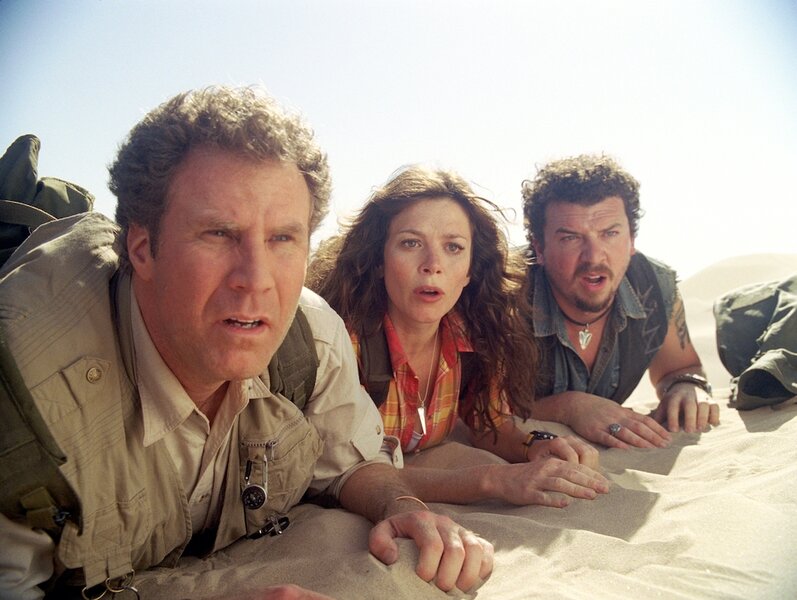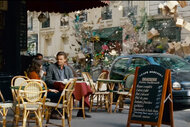Create a free profile to get unlimited access to exclusive videos, sweepstakes, and more!
Land of the Lost Director Looks Back at What Could've Happened in a Sequel
SYFY WIRE catches up with director Brad Silberling and co-screenwriter Chris Henchy!

Ever heard of a Sleestak? What about a Tachyon Amplifier? Does the term "Pakuni" ring any bells? No, we're not speaking gibberish over here — we're talking about 2009's Land of the Lost, and why you need to check it out, pronto!
Good thing it's streaming on Peacock at the moment...
Based on the '70s-era television series of the same name created by the inimitable duo of Sid and Marty Krofft (known for kid-friendly and Saturday morning touchstones like H.R. Pufnstuf), the film stars Will Ferrell as Dr. Rick Marshall, a cocky and discredited scientist who finds himself transported to a strange alternate dimension inhabited by a man-eating T. rex named "Grumpy"; bug-eyed lizard people (Sleestaks); a civilization of shaggy ape-men (the Pakuni); giant, blood-sucking insects; kaiju-sized crustaceans; and the derelict remnants of various time periods (cars! motels! corpses!).
"It's a cosmic lost and found," Marshall explains to his cohorts: fellow academic Holly Cantrell (Anna Friel) and slacker Will Stanton (Danny McBride). "A virtual land of the lost."
We call it a surreal, Salvador-Dalí-meets-Edward Hopper breeding ground for an absurdist gem of a film that didn't get enough love upon its initial release. More on that later, though.
Changes from original Land of the Lost TV series
In the original show, Holly and Will were depicted as Rick's children, but were aged up and reimagined as strangers for the film "just so that we wouldn’t have to be stuck in a PG world, and it would hopefully bring [in] a new audience," Christopher Henchy, who co-wrote the movie with SNL vet Dennis McNicholas, tells SYFY WIRE, explaining why the decision was made to turn the property into an irreverent comedy for older audiences (the project ended up with a PG-13-rating). "It’s that world where the show is long enough ago, that most people going to see it probably were not really that familiar with it."
That ideology was also applied to Chaka, a member of the Pakuni who befriends the group after he's left for dead in the middle of the desert. Played by Lonely Island co-founder Jorma Taccone, Chaka was given a more risqué personality than he had in the Land of the Lost television series, "which we got in a little trouble for," Henchy admits.
Beyond those notable character tweaks, however, everything else pretty much remained the same, albeit with the tonal caveat that the material wouldn't be taken too seriously. "It’s like the old 'Abbott and Costello Meet Blank,'" says the movie's director, Brad Silberling (also known for helming beloved childhood classics like 1995's Casper and 2004's A Series of Unfortunate Events). "You’re taking the ethos of those horror movies, but you’re sticking in the wrong guys."
This desire for levity is best exemplified by Rick's Tachyon Amplifier, an inter-dimensional device cobbled together from everyday items, including a faulty iPod that plays "I Hope I Get It" from A Chorus Line on repeat. Tied to Rick Marshall's established love of show-tunes, the musical bit gets reprised several times throughout the film, reaching its comedic pinnacle during a sequence where the gang must retrieve the Amplifier (their only hope of getting back home) from a volcanic Pterodactyl's nest.
"We debated amongst ourselves and it’s often like the first actor in the room gets job," Silberling remembers when asked whether other Broadway songs were considered. "Chorus Line was the very first thought, but we kind of tested it with ourselves. We were going back and listening to stuff from Oklahoma; we were listening to all sorts of [show tunes], but nothing beat it. Every time you heard it, it just made us laugh ... I always had it on standby, so I could play it out loud onstage for everybody to remember just how absurd the whole situation was."
A majority of the filming took place at the Universal soundstages against the backdrop of massive, practical sets constructed by legendary production designer Bo Welch (Men in Black, Thor). "What was not to love?" Henchy insists. "We were on these tremendous soundstages in Universal with these sets you couldn’t believe were being made. Brad had such a grasp on it and Bo was so into it. The thing was huge, and it feels great when you’re doing it. It’s pure and it’s yours."
Practical vs. digital effects
An old school charm (derived not only from the low-budget nature of the Krofft TV show, but from 1968's Planet of the Apes, the films of Andrei Tarkovsky, and sci-fi B-movies of the 1950s) pervades the whole affair — from the look of the men-in-rubber-suit Sleestaks, complete with radio-operated heads, to the Jerry Goldsmith-inspired score of Michael Giacchino (Spider-Man: No Way Home, The Batman).
"We wanted to make things as practical on set as possible because I think it always looks better," Henchy says. "I would almost say the original Planet of the Apes was more terrifying than the CGI ones they have now. It feels more tactile."
The production team briefly considered taking a similar approach to the dinosaurs by utilizing the herky-jerky stop-motion effects of the original series, but ultimately decided against it. "Everybody, including the studio, was like, ‘No, we’re post-Jurassic Park now. We can’t take a step back,’" Silberling says.
Despite some minor CGI alterations made to their mouths (see below), the Sleestaks were brought to life by a small army of extras. "We had to audition all of these guys who had to be of a certain height," the director adds. "Of course, they all lie and go, ‘Oh yeah, I’ve done suit work’ and many of them haven’t. But we just had a bunch of them there — very hot conditions onstage. There were full-time PAs just going around trying to give them sips of water."
A number of scenes required a real-world desert location, which brought the crew to the naturally-occurring Pinnacles and borax-rich salt flats of Trona, California — "this crazy prehistoric-looking location out in the desert," Henchy explains. "Just being out there in the hot sun and Jorma in a full rubber outfit losing five pounds a day in water and sweat. It was a fantastic, great movie-making experience with very talented people and stuff that looks great."
After retrieving the Tachyon Amplifier from the volcano, our heroes celebrate at a motel situated in the middle of nowhere, chilling out by the pool and and inadvertently getting high on the juice of a psychedelic fruit. "We just loved the idea of the language of the old desert motel," Silberling continues. "The only thing that’s digital in that whole sequence at the motel is just the extra moon [in the sky] because the entire set, including the pool and all of the signage, was all built there ... it remains one of my favorite sets ever."
The motel scene ends with Rick, Will, and Chaka snacking on a giant boiled crab with an oversized lemon wedge — a bizarre and hilarious visual that wouldn't feel out of place in a movie produced by Mel Brooks or the Airplane! trio of Jerry Zucker, David Zucker, and Jim Abrahams. According to Silberling, the larger-than-life shellfish (and accompanying citrus slice) was an homage to "the canon of sci-fi cinema" like 1957's Attack of the Crab Monsters.
"We’re like, ‘OK, let’s take it to the next step, what happens if the crab ends up being boiled? These guys are wasted anyway, so let’s build the giant lemon wedge.’ That whole sequence where they’re eating that and tripping balls [was] all completely improvised, which is why the camera moves in, but never cuts away. We timed it for the perfect moment at magic hour and so, there was this certain degree of risk to it. But oh my God, those guys kill me."
Land of the Lost post-credit scene and sequel set-up
Just a year after the release of Iron Man — and long before additional teasers were a common sight in every Hollywood blockbuster — Land of the Lost featured a mid-credits scene in which a baby Sleestak hatches from an egg Rick brings back to Earth to prove his crackpot theories were true.
"You could’ve done the Jurassic 2 [The Lost World] thing and have the issue on Earth," Silberling says, going on to add that the stinger was more about rewarding the audience for watching the credits and less about setting up another chapter. "I’m big for the credits sequences … There’s an army of people who work on these movies. Those credits can take 10 minutes, so you better make sure that there’s some entertainment value if you want people to stick around."
Besides, the director admits they "never got that far" on sequel talks, anyway. "It would’ve been tough because so many of the juiciest elements that you’re playing with in the film is sort of first date energy of these people in this world and the fear would’ve probably been a bunch of retread."
"You don’t want to jinx a movie, thinking, ‘Hey, we should do a sequel,’" echoes Henchy. "And then, very quickly on whatever date that came out, we knew there wasn’t going to be a sequel. I never thought of a sequel. I never thought that far [ahead]."
"There's a million what-ifs"
Land of the Lost opened in theaters across the country on June 4, 2009 to critical and box office disappointment. The film carried a rather hefty price tag of $100 million (largely due to the dinosaur effects), but only managed a global draw of just over $68 million. This lackluster financial performance may have been due to the fact that one of the biggest comedies of all time — Todd Phillips' The Hangover — had released two days before. Rick Marshall & co. never stood a chance.
"People saw that and that’s what they wanted. Land of the Lost just wasn’t that," Henchy says of the raunchy Vegas bachelor party odyssey fronted by Bradley Cooper, Ed Helms, and Zach Galifianakis. "I think we got stuck a little bit in between pivoting to make it a little more family-friendly at the last minute when we probably should have leaned more [into the adult side]. There’s a million what-ifs."
With that said, time has been kind to Land of the Lost, which now enjoys a cult status amongst the stoner community. "There are people who like to get high and watch it. There are funny, funny moments in it. I’ll catch it on cable and stop and watch and go, ‘It’s still pretty funny,’" Henchy continues. "It’s something I’m still very proud of ... We all are. We worked really hard on it and I think Brad did an amazing job. It looks amazing and there are some really, really funny moments in it. Give it a second shot…or a first shot."
For Silberling, who revisited the title ahead of our interview, the film is worth another look for "the sheer pleasure of imagination and character humor, side-by-side." The director concludes: "As a filmmaker, you’re living with these films so intensely and then you go away from them for a long time sometimes. When you come back, you really do get to appreciate elements of what’s been accomplished, and I did. I loved the imagination of it, its sense of play and playfulness. I have friends who [have it on] high rotation [during] certain times of the year and they’ll suddenly call and talk about Will dumping the dinosaur piss on his head again. So there’s sequences that just live for people ... It’s a great eyeful in terms of visual artistry and just really playful performances."
Land of the Lost is now streaming on Peacock.
Originally published May 3, 2023.





























